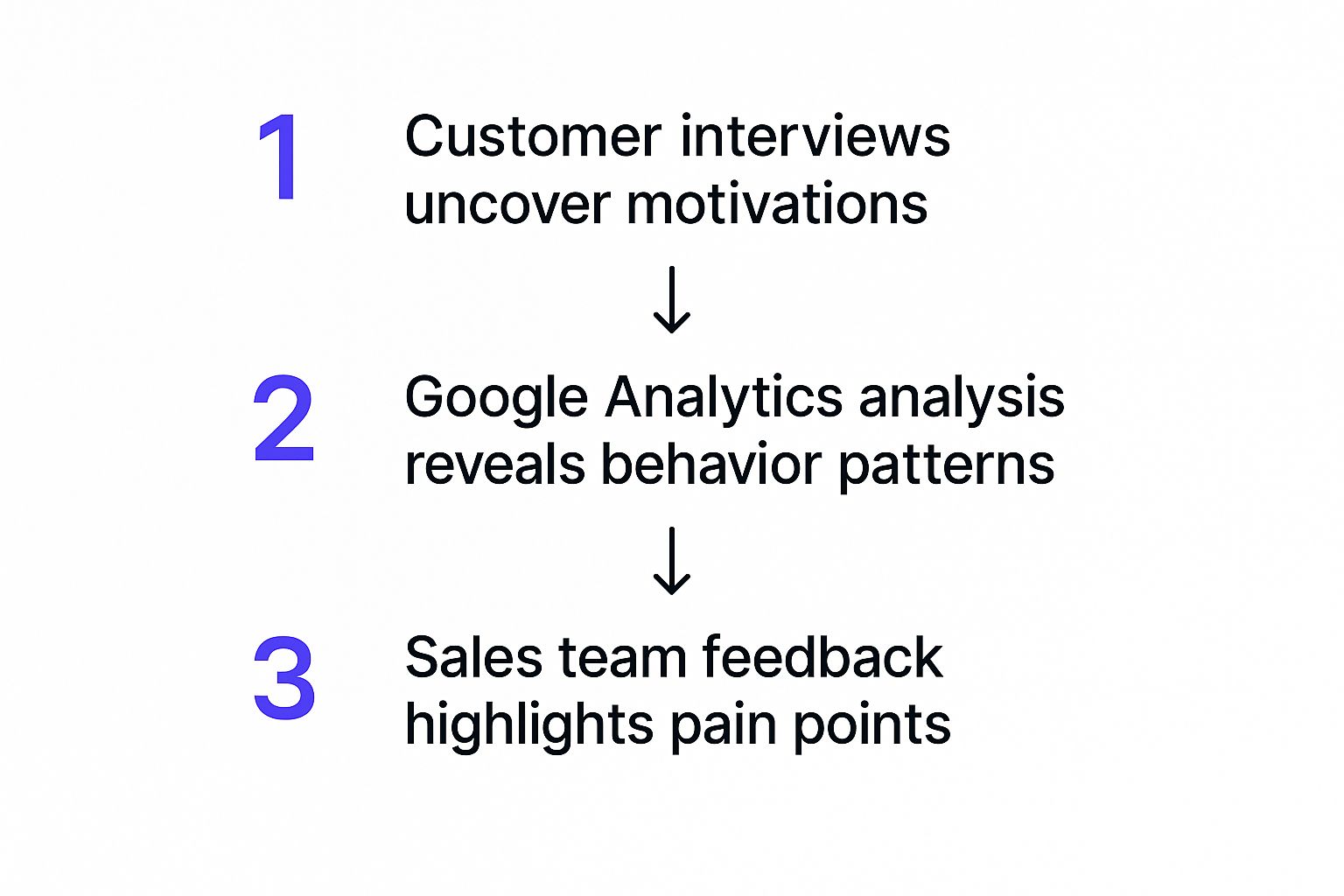How to Create Buyer Personas That Drive Growth
Buyer personas. The term gets thrown around in marketing meetings so often it's practically a buzzword bingo free space. At its core, it’s about building a detailed, research-backed profile of your ideal customer. It's about mixing real customer data with solid market research to finally understand what makes them tick—their goals, what keeps them up at night, and what they really want.
Done right, this process makes sure your messaging, your product, and your entire strategy actually connect with the people you’re trying to reach.
Why Most Buyer Personas Fail And How to Make Yours Work

Let's get real for a second. A lot of buyer personas are DOA—dead on arrival. They end up as forgotten PDFs, collecting digital dust in a shared drive somewhere.
Why? Because they’re treated like a one-and-done marketing task, a box to check off. They fail when they're built on flimsy assumptions and generic templates, which means they're too shallow to be of any real use.
These surface-level profiles don't inspire anyone. Your team can't connect with "Marketing Mary," a vague caricature slapped together with a stock photo and some made-up hobbies. That disconnect is exactly why so many marketing efforts fall flat. In fact, many of the big problems in sales and marketing, like the diminishing returns of cold outreach, can be traced right back to a fuzzy, inaccurate picture of the audience.
The Shift from Task to Strategic Tool
A truly effective persona is a living, breathing document. It's grounded in real-world data and actual customer conversations. It completely changes how you operate by giving everyone a crystal-clear, shared understanding of who you’re actually serving.
This isn't just a tool for the marketing department. Its impact ripples across the entire business:
- Ad Copy: Forget generic messaging. You can write ads that speak directly to a specific, nagging pain point your persona deals with every single day.
- Product Development: Feature requests get prioritized based on what would solve a genuine problem for your ideal customer, not just on what sounds cool in a brainstorming session.
- Sales Conversations: Your sales team can walk into a conversation already knowing the likely objections and can tailor their pitch to what genuinely matters to the prospect.
The goal here isn't to just fill in the blanks on a template. It's to build a strategic asset that gives your business a serious competitive edge. It’s the difference between shouting into the void and having a meaningful conversation with someone who actually wants to listen.
When you really invest in understanding the "who" and the "why," your entire strategy snaps into focus. (For more on connecting strategy to action, check out our guide on marketing automation best practices.)
A persona built on real insights is your compass. It ensures every decision—from a single email subject line to your entire product roadmap—is pointing directly toward customer needs.
The Measurable Impact of Well-Crafted Personas
The benefits aren't just fluffy theory, either. They show up right on the bottom line. When companies actually commit to keeping their personas up-to-date, the results are powerful.
Consider this: over 60% of companies that refreshed their buyer personas within the last six months blew past their lead generation and revenue goals. That's a massive tell. It shows just how critical it is to align your marketing with what customers actually need, right now.
These high-performing companies don't just stop there. They also map over 90% of their customer database by persona, which allows for ridiculously precise targeting and personalization.
Gathering Real Insights for Accurate Personas
Authentic buyer personas aren't dreamed up in a boardroom brainstorming session. They’re built on a foundation of real-world data. If you’re just guessing, you’ll end up with generic profiles that feel hollow and fail to connect.
To really understand your ideal customer, you need to become a detective. Your job is to gather clues from multiple sources and piece together a complete, accurate picture of who they are, what they need, and why they act the way they do.
This process is all about blending two types of information: qualitative data (the "why" behind their actions) and quantitative data (the "what" and "how" of their behavior). One tells you the story; the other provides the hard evidence to back it up.
This infographic gives you a bird's-eye view of how different data sources flow together to create a persona that actually works.

As you can see, each piece of the puzzle is essential, moving from deep personal motivations to broad behavioral patterns. Let's dig into where you can find this gold.
Uncovering Motivations Through Customer Conversations
The richest, most nuanced insights will always come directly from the source. Talking to your customers is non-negotiable for creating buyer personas that feel like real human beings. These conversations are where you uncover the details that spreadsheets and analytics reports will never show you.
Your goal isn't just to ask surface-level questions. You need to dig deep and get them to tell you their stories.
- Existing Customers: These are your best friends in this process. They chose you for a reason. Ask them to walk you through their entire buying journey, right from the beginning. What was the exact problem they were trying to solve when they first started looking for a solution like yours?
- Prospects in the Pipeline: These folks are actively making a decision right now. Their perspective is invaluable for understanding the current competitive landscape and the immediate barriers they’re facing. What’s holding them back? What are they comparing you to?
- Customers Who Churned: I know, it can be tough to hear. But these conversations are a goldmine. Understanding why someone left reveals crucial information about product gaps, unmet expectations, or messaging that just didn't land right.
When you're doing these interviews, lean into open-ended questions that encourage storytelling. Instead of asking, "Do you like our product?" try something like, "Can you tell me about a time our product helped you solve a specific problem at work?" The difference in the quality of the answer will be night and day.
Pro Tip: Aim to interview at least 5-8 people for each potential persona you're building. After a handful of conversations, you'll start hearing the same themes, pain points, and goals pop up again and again. Those recurring patterns are the building blocks of an accurate profile.
Analyzing Behavior with Quantitative Data
While interviews give you the "why," your analytics platforms give you the "what." This is where you validate the stories you've heard with cold, hard data, ensuring your personas aren't just based on a few compelling anecdotes.
Creating buyer personas involves a careful mix of both qualitative and quantitative data to build profiles that are not only accurate but also actionable. Experts often start with a wide net, pulling from market research, surveys, and interviews. Then, tools like Google Analytics become vital for layering in behavioral data—showing where your visitors come from, how they navigate your site, and what content actually convinces them to convert. You can discover more about data-driven persona development and its methodologies to get even deeper.
To start, you need to dig into these key areas:
- Website Analytics: Where are your best customers coming from? Check out your referral sources in Google Analytics. Which blog posts and pages are the most popular? This tells you what topics truly resonate with your audience.
- CRM Data: Your CRM is a treasure trove. Sift through it to find trends in job titles, company sizes, and industries among your most successful customers. This is how you'll nail the demographic and firmographic details of your persona.
- Sales Team Feedback: Your sales team is on the front lines every single day. They have a direct line to the common questions, objections, and "aha!" moments that prospects experience. Schedule regular check-ins with them to gather these raw, unfiltered insights. It’s pure gold.
This quantitative analysis adds a crucial layer of objectivity to your research. For example, if your interviews suggest your persona values detailed case studies, but your analytics show that short video testimonials get 150% more engagement, you’ve just uncovered a vital insight about their real-world content habits.
It’s this powerful combination of stories and stats that transforms a simple sketch into a high-fidelity portrait of your ideal customer.
Finding the Patterns in Your Customer Data

You've done the legwork. You’ve wrangled interviews, collected surveys, and stared at analytics until your eyes glazed over. Now you're sitting on a mountain of interview transcripts, spreadsheets, and messy notes. This is where the real fun begins—turning all that raw data into the backbone of your buyer personas.
Your job isn't to document every single tidbit of information. It's to become a detective. You're looking for the recurring themes and common threads that tie seemingly different people into a neat, cohesive group.
This is the pivot from a jumble of individual stories to a clear, segmented view of your customer base. Think less spreadsheet jockey, more pattern-finder.
Start with High-Level Grouping
Before you get lost in the weeds, start by sorting your research into broad categories. Don't overthink it. A simple spreadsheet works, but I’ve always found that a wall full of sticky notes is where the magic really happens.
Start bucketing your data points and interview responses based on the obvious identifiers you collected:
- Job Roles: Pull together all the VPs of Marketing, the freelance developers, or the small business owners.
- Company Size: Create separate piles for the scrappy startups, the mid-market players, and the massive enterprises.
- Industry: Cluster everyone from healthcare, SaaS, retail, or whatever sectors you serve.
This first pass helps you see if any natural segments are already taking shape. Maybe you notice that every single person from a startup mentions budget constraints, while your enterprise contacts are obsessed with security and integration. Those are the first clues.
Don't fall into the trap of creating a dozen micro-personas. The goal here is to nail down the 2-3 core groups that probably account for 80% of your revenue. It’s all about quality over quantity.
Dig Deeper to Uncover Core Motivations
With your initial groups looking solid, it's time to sift through the good stuff—your qualitative data. Pore over those interview notes to find the why behind their actions. Look for the common answers to the big questions that reveal what truly drives their decisions.
This is where you unearth the emotional and logical triggers for each group. Zero in on the recurring themes in these areas:
- Pain Points: What specific frustrations or challenges were mentioned over and over again by people in the same bucket? Write down their exact words, like "wasting way too much time on manual data entry" or "I have zero visibility into my team's performance."
- Goals and Aspirations: What are they actually trying to achieve? Look for the desired outcomes, whether it's "getting a promotion," "making my team more efficient," or "finally proving the ROI of my department to my boss."
- Buying Triggers: What was the final straw that sent them looking for a solution like yours? Was it a bungled project, a new top-down company initiative, or sudden pressure to slash costs?
As you go, you’ll see certain pains and goals naturally clustering together. The "Project Manager" group, for instance, might consistently bring up the pain of missed deadlines and the goal of better team collaboration. That cluster of related motivations? That's the heart of a persona.
How to Prioritize Your Persona Groups
Okay, you've identified several potential segments. Now you have to decide which ones deserve your focus first because not all segments are created equal. Trying to cater to everyone is a surefire way to connect with no one.
Prioritize based on straight-up business impact. Here’s a simple framework:
| Revenue Impact | This group represents your most profitable customers. | Which segment has the highest customer lifetime value (CLV)? |
|---|---|---|
| Market Opportunity | This segment has serious growth potential. | Is this an underserved market where we can gain traction fast? |
| Alignment | Your solution is the perfect antidote to this group's problems. | Do we solve this segment's main pain points better than anyone else? |
By zeroing in on the segments that score highest here, you ensure the personas you build will actually move the needle for your business. This isn't just an academic exercise; it's strategy. To get a better handle on this, you can explore various customer segmentation strategies to make sure your personas are as strategic as they are descriptive.
Crafting a Persona Profile Your Team Will Actually Use

All that hard work—the interviews, the surveys, the late-night data dives—it all leads to this moment. Now you have to translate those raw insights into a living, breathing document that your team can actually grab and use on a Tuesday morning.
A great persona profile is so much more than a list of facts; it’s a story that makes your ideal customer feel real.
The biggest mistake I see teams make is creating a persona that’s just a dry collection of demographics and buzzwords. "Marketing Manager Molly" ends up as a forgotten file on a shared drive because no one can actually relate to her. To stop that from happening, we need to build a compelling narrative that brings her to life.
Beyond Demographics: Weaving a Narrative That Sticks
Your persona profile needs a soul. The fastest way to give it one is by crafting a "day in the life" story that paints a vivid picture of their reality. Don't just list their job duties. What's the first thing they do when they get to work? What’s that one meeting they dread all week?
Think of it this way: demographics tell you who your customer is, but a narrative tells your team why they should care. This story is the glue that holds the entire profile together, making it memorable for everyone from sales reps to product designers.
For example, instead of just saying a persona is a "Project Manager," you could write something like this:
“Alex starts his day with a fresh wave of anxiety, staring at a Gantt chart that’s already turning red. He spends the first hour fielding panicked Slack messages about missed deadlines before his back-to-back meetings even begin. His biggest dream is to run one project, just one, that finishes on time and under budget so he can finally get some recognition from leadership.”
See the difference? Now Alex is a person with real struggles, not just a job title. That's the foundation of a persona that people will actually use.
The Non-Negotiables: Core Components for Every Persona Profile
Once you have the narrative, you need to structure the profile with clear, scannable sections that give your team actionable information. A cluttered, hard-to-read persona is a useless one.
Here are the elements every profile needs to become a go-to resource for your entire organization:
- Name and Photo: Give your persona a realistic name and a stock photo that feels authentic. It makes them instantly more human.
- Role and Responsibilities: Detail their job title, who they report to, and what key metrics they're responsible for. This is crucial for helping your sales team understand their professional context.
- Goals: What does success look like in their role? List their primary and secondary professional goals.
- Challenges and Pain Points: This is arguably the most important section. What are the biggest obstacles standing in their way? Use direct quotes from your interviews here for maximum impact.
- Watering Holes: Where do they go for information? Name specific blogs, LinkedIn influencers, podcasts, or conferences they trust. This is a goldmine for your content and ad teams.
- How You Help: A brief, clear statement explaining exactly how your product or service helps them nail their goals and crush their challenges.
To make sure your persona document is both comprehensive and easy to scan, here’s a quick breakdown of what to include for each component.
Essential Components of a Buyer Persona Profile
| Name & Photo | A realistic name and an authentic-looking stock photo to humanize the persona. | "Founder Frank" with a photo of a relatable entrepreneur. |
|---|---|---|
| Role & Responsibilities | Their job title, who they report to, and the key metrics they own. | "Owner of a growing e-commerce store, responsible for revenue growth and operations." |
| Goals | The primary and secondary outcomes they are working toward in their role. | "Increase profit margins by 15% this year; step away from day-to-day tasks." |
| Challenges & Pain Points | The specific, recurring frustrations that get in their way. Use direct quotes. | "I'm buried in spreadsheets trying to track inventory, and my ad spend feels like a black hole." |
| Watering Holes | The specific blogs, podcasts, influencers, and conferences they trust for information. | "Listens to the My First Million podcast; follows Nik Sharma on Twitter." |
| How You Help | A clear statement connecting your solution to their goals and pains. | "Our platform unifies inventory and ad data, giving Frank a clear ROI view." |
This structured approach ensures that anyone on your team can glance at the profile and immediately understand your customer's world.
Key Takeaway: The goal isn’t just to describe your customer, but to equip your team with the empathy and insights needed to connect with them authentically. A great persona serves as a constant reminder of the real person on the other side of the screen.
When your team starts saying, "What would Frank think about this campaign?"—that's when you know you’ve nailed it.
Putting Your Personas into Action
Building a detailed buyer persona is a serious win, but let’s be real—it's only half the job. A persona that isn't being used daily is just a well-researched document collecting digital dust on a server somewhere.
The real magic happens when you move from research to revenue. It’s about taking those hard-won insights and embedding them into the daily grind of your marketing, sales, and product teams. When everyone is on the same page about who the customer actually is, every decision gets sharper, smarter, and way more effective.
Fueling Your Marketing Engine
For marketers, personas are the ultimate cheat sheet. You get to stop guessing what might work and start creating content and campaigns with the confidence that you're hitting the right notes.
This is where your research pays off big time:
- Content Creation: Does "Founder Frank" prefer quick, punchy video tutorials over 3,000-word blog posts? Your content calendar should reflect that. Knowing his biggest pain point is "feeling like my ad spend is a black hole" gives you the perfect topic for your next webinar or LinkedIn post. Easy.
- Ad Targeting: On platforms like LinkedIn or Facebook, you can ditch the broad demographic targeting. Use your persona insights—job titles, industries, even the specific influencers they follow—to build hyper-targeted audiences. You'll stop burning cash on irrelevant clicks.
- Email Marketing: Segment your email list by persona. A welcome sequence for "Founder Frank" should sound completely different from one for "Agency Alice." That kind of personalization is what drives mind-blowing results.
And this isn't just fluffy marketing talk; the numbers are legit. Brands that use personas in their email campaigns see 18 times more revenue than those blasting out generic emails. They also see click-through rates jump by 14% and conversion rates climb by 10%.
Empowering Sales and Product Development
Personas aren't just a marketing toy. They're a powerful tool for aligning your entire customer-facing strategy, breaking down those pesky silos between departments.
For Your Sales Team
Think of a persona profile as a pre-call briefing doc. Before your reps even pick up the phone, they can understand a prospect's likely goals, challenges, and communication style. This lets them tailor their pitch from the very first hello.
Suddenly, your reps can:
- Anticipate objections before they even come up.
- Frame the product's value in a way that speaks directly to that persona's top priorities.
- Build genuine rapport way faster because they're speaking the customer's language.
A persona helps a salesperson shift their mindset from "What can I sell?" to "How can I solve their specific problem?" This empathetic approach is what closes deals and builds long-term relationships.
For Your Product Team
It's easy for product development to get disconnected from the actual end-user. Personas serve as a constant, human reminder of who will be using the product every single day.
- Feature Prioritization: When the team is debating what to build next, they can ask, "Which of these features would solve a bigger headache for Founder Frank?" This grounds the product roadmap in real user needs, not just cool tech possibilities.
- User Experience (UX): Designers can use the persona’s story and technical skills (or lack thereof) to shape the interface. The goal is to build something so intuitive it feels like it was made just for them.
Once your personas are clearly defined, it's time to integrate them fully into your marketing and sales engine. To dig deeper, check out these strategies for using buyer personas to accelerate B2B marketing and sales. This whole process is a cornerstone of any solid go-to-market strategy, which you can map out with our marketing campaign planning template.
By putting your personas to work, you transform them from a research project into a powerful engine for customer-centric growth.
Got Questions About Building Buyer Personas? Let’s Clear Things Up.
Even with a killer process, hitting a few roadblocks while you're figuring out how to create buyer personas is totally normal. It's easy to get stuck wondering if you're even on the right track.
Let’s tackle some of the most common questions and sticking points. By the end, you'll have the clarity and confidence to finalize those profiles and put them to work.
How Many Buyer Personas Do I Actually Need?
This is the big one, and the answer is refreshingly simple: quality will always, always beat quantity.
There’s no magic number here. But from my experience, most businesses hit the sweet spot with 2-4 core personas. These core groups usually represent about 80% of your customer base and, more importantly, your revenue.
Trying to juggle a dozen different profiles is a recipe for disaster. You end up with a stack of superficial, unusable documents that just collect digital dust.
If you find your personas feel way too similar, with nearly identical goals and challenges, that's a huge sign you can merge them. On the flip side, if one persona feels so broad it's almost generic, it might be time to split that character into two more focused profiles.
Start with just one or two of your most impactful customer segments. Build them out completely, start using them in your marketing, and only then should you think about expanding. The goal is an actionable tool, not a massive library of shallow profiles.
Is a Buyer Persona Just a Fancy Name for a Target Audience?
Not even close, and getting this difference right is what separates personas that work from ones that flop. They're related, for sure, but they do completely different jobs for your strategy.
A target audience is the wide-angle shot. It’s a broad description of a group, defined mostly by demographics.
- Example: "Marketing managers, aged 30-45, working at B2B tech companies with 50-200 employees."
This tells you who you’re talking to, but it stops right there. A buyer persona is the close-up. It's a detailed, semi-fictional character you've built from real research. It digs into the why and the how behind their decisions.
- Example: "Marketing Manager Molly is drowning in spreadsheets, trying to prove campaign ROI. She feels constant pressure from her CMO to show her team's value but can’t because all her data is siloed. She gets her industry news from the Marketing Over Coffee podcast and secretly wishes she had a dashboard that just worked."
See the difference? A target audience gives you a market to aim at. A buyer persona gives you a human being to connect with.
How Often Should I Update My Personas?
Think of your buyer personas as living documents, not ancient artifacts carved in stone. Markets change, customer behaviors evolve, and new challenges pop up all the time. A persona you built three years ago might be totally clueless about today's world.
As a rule of thumb, plan to review your personas annually. Just put it on the calendar. This gives you a dedicated moment to ask, "Does this still feel right? Does this still sound like our ideal customer?"
But honestly, the calendar isn't the only trigger.
You should revisit your personas anytime you notice:
- A Major Market Shift: A new competitor rolls into town, or a new piece of tech changes the game.
- A Big Product Launch: You’ve rolled out a new service or feature that’s suddenly attracting a different kind of customer.
- A Change in Customer Behavior: Your analytics show a completely new user journey, or the sales team keeps hearing new objections on their calls.
Keeping your personas fresh ensures your entire strategy—from the content you create to the emails your sales team sends—stays sharp, relevant, and effective.
Ready to build a marketing strategy that actually connects? At Rebus, we build data-driven campaigns that don't just get seen—they get results. Let our team help you turn deep customer insights into real, measurable growth. Supercharge your marketing with us.
